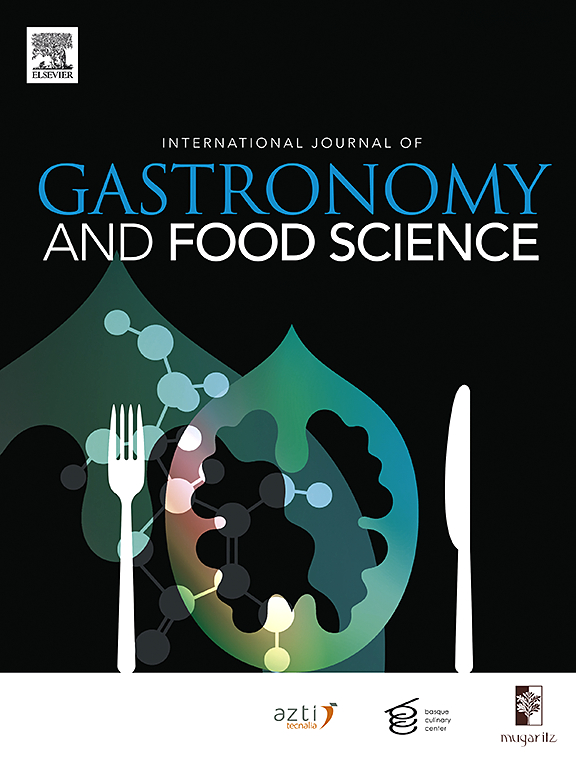Menu fatigue: Exploring an obscure concept with problem-centred expert interviews
IF 3.2
2区 农林科学
Q2 FOOD SCIENCE & TECHNOLOGY
International Journal of Gastronomy and Food Science
Pub Date : 2024-10-30
DOI:10.1016/j.ijgfs.2024.101047
引用次数: 0
Abstract
The study aims to explore menu fatigue by defining its dimensions and the actors involved. It also aims to establish a model that reflects the paradigmatic nature of the concept. Given the paucity of literature to support the objectives, it was considered appropriate to conduct the study using a qualitative research approach. Accordingly, a grounded theory approach with problem-centred expert interviews was used to collect data, which is recommended for investigating issues that are not clearly defined and not well established, with the direct contribution of those who have sufficient knowledge of the concept being researched. First, the "what" and "who" questions were put to the only actor identified in the literature, the customer. In this way, the definition of menu fatigue was broadened and other actors to be studied were identified. Similar questions were asked of other actors such as administrative and owner/manager chefs, kitchen staff and service staff, who were also found to be affected. This cumulative approach made it possible to select 24 experts to contribute to the study. Participants were identified through purposive and theoretical sampling. The results of the two-stage coding showed that menu fatigue is not only about monotony, which is the only dimension associated with the concept in the literature, but also about excessiveness, appearance and extra effort. While previous literature accepted menu fatigue in industrial settings as an issue of customer boredom and perceived monotony, the current paper extended the concept to include newly explored dimensions and actors. Secondly, the highlighted dimensions and actors were linked to their occurrence and subsequent outcomes to be presented in a model of menu fatigue that provides a more comprehensive understanding of the issue. The paper concludes with implications for both academic and industrial practitioners.
菜单疲劳:以问题为中心的专家访谈:探索一个模糊的概念
本研究旨在通过界定菜单疲劳的各个方面和相关参与者来探讨菜单疲劳问题。研究还旨在建立一个反映这一概念范式性质的模型。鉴于支持研究目标的文献很少,我们认为采用定性研究方法进行研究是合适的。因此,采用了以问题为中心的专家访谈的基础理论方法来收集数据,这种方法被推荐用于调查那些定义不明确、没有得到很好证实的问题,由对所研究的概念有足够了解的人直接参与。首先,"是什么 "和 "谁 "的问题是向文献中唯一确定的行为者--顾客提出的。通过这种方式,菜单疲劳的定义得到了扩展,并确定了需要研究的其他参与者。我们还向其他参与者提出了类似的问题,如行政人员、业主/经理厨师、厨房员工和服务人员,他们也被认为受到了影响。通过这种累积方法,选出了 24 名专家参与研究。参与人员是通过目的性和理论性抽样确定的。两阶段编码的结果表明,菜单疲劳不仅涉及单调(这是文献中与该概念相关的唯一维度),还涉及过度、外观和额外努力。以前的文献将工业环境中的菜单疲劳视为顾客感到无聊和单调的问题,而本文则扩展了这一概念,纳入了新探索的维度和参与者。其次,将所强调的维度和参与者与它们的发生和后续结果联系起来,以菜单疲劳模型的形式呈现,从而更全面地理解这一问题。本文最后提出了对学术界和工业界从业人员的启示。
本文章由计算机程序翻译,如有差异,请以英文原文为准。
求助全文
约1分钟内获得全文
求助全文
来源期刊

International Journal of Gastronomy and Food Science
Social Sciences-Cultural Studies
CiteScore
5.30
自引率
10.50%
发文量
170
审稿时长
45 days
期刊介绍:
International Journal of Gastronomy and Food Science is a peer-reviewed journal that explicitly focuses on the interface of food science and gastronomy. Articles focusing only on food science will not be considered. This journal equally encourages both scientists and chefs to publish original scientific papers, review articles and original culinary works. We seek articles with clear evidence of this interaction. From a scientific perspective, this publication aims to become the home for research from the whole community of food science and gastronomy.
IJGFS explores all aspects related to the growing field of the interaction of gastronomy and food science, in areas such as food chemistry, food technology and culinary techniques, food microbiology, genetics, sensory science, neuroscience, psychology, culinary concepts, culinary trends, and gastronomic experience (all the elements that contribute to the appreciation and enjoyment of the meal. Also relevant is research on science-based educational programs in gastronomy, anthropology, gastronomic history and food sociology. All these areas of knowledge are crucial to gastronomy, as they contribute to a better understanding of this broad term and its practical implications for science and society.
 求助内容:
求助内容: 应助结果提醒方式:
应助结果提醒方式:


